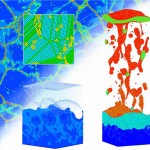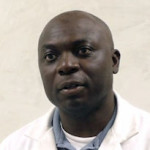In 2011, NICS set out to explore ways researchers could take advantage of emerging processing technologies. Prompted by the shift in the computing landscape to parallelism for meeting increasing performance needs, NICS researchers proposed to port and optimize scientific codes to the Intel Xeon Phi coprocessors. To read more about this process download this white paper.
NICS Gets Faster Application Performance with the Cray® CS300™ Cluster Supercomputer Based on Intel® Xeon Phi™ Coprocessors
Supercomputing the Mystery of Astrophysical Jets
Over at NICS, Scott Gibson writes that researchers are using XSEDE supercomputing resources to simulate the gaseous outflows from black holes known as astrophysical jets. “These jets can affect galaxy formation and evolution by, for example, heating up the surroundings and suppressing star formation, expelling the surrounding gas and thereby reducing the mass supply to the black hole.”
Podcast: Simulating how Lasers can Transform Materials
Researchers are using XSEDE compute resources to study how lasers can be used to make useful materials. In this podcast, Dr. Zhigilei discusses the practical applications of zapping surfaces with short laser pulses. Laser ablation, which refers to the ejection of materials from the irradiated target, generates chemical-free nanoparticles that can be used in medical applications, for example.
Podcast: XSEDE Powers Search for How the Earth was Formed
In this NICS podcast, Scott Gibson discusses how the Earth was formed with Wladimir Lyra, an assistant professor at California State University at Northridge, Department of Physics and Astronomy. Lyra is using XSEDE supercomputing resources to explore this age-old question.
Video: HPC Transforms Diagnostic Medical Imaging
In this video, Justin Baba from the University of Tennessee and Oak Ridge National Laboratory describes how HPC transforms medical diagnostic imaging. “A lot of studies have been published on the impact of detecting or tracking the polarization of photons,” Baba says. “But there isn’t much understanding of what is actually occurring as these photons are scattering and propagating through the media. We have captured step by step what is taking place at each scattering event and the effects on the photons’ properties due to a scattering event. So we are able to elucidate what is already out there in the literature.”
Supercomputing Sudden Firestorms
Over at NICS, Scott Gibson writes that researchers are using supercomputers to model the spread of wildfires.
Podcast: Supercomputing the Impact of Deepwater Horizon
Lead by Project Principal Investigator Annette Engel from the University of Tennessee at Knoxville, the research has uncovered fundamental changes in the types of bacterial communities associated with oil and carbon degradation of importance to oil quality and quantity, as well as to the overall ecosystem of the Gulf Coast area.
Podcast: Using Allinea Programming Tools to Speed XSEDE Supercomputing Research
“In my humble opinion, I think that debuggers and profiling tools are far too infrequently used. And it’s not because they’re not there. It’s because people just either don’t know about them, don’t do training on them, or don’t know how to use them. We’re in a state where we have less cycles than we’ve ever had per request, right? So being able to take full advantage of those cycles by having optimized code and optimized run patterns is crucial. Otherwise, you’re just not going to be able to get your work done and the science won’t get done.”










